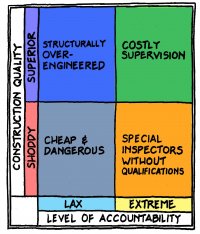The Council of American Structural Engineers published a
Guide to Special Inspections (
https://community.acec.org/HigherLo...519-5bdc-435f-a444-b32c8870137a&forceDialog=1 ) that goes into more detail than the IBC regarding how a special inspections program should be run. The CASE
Guide makes it clear that there can (and should) be more than one Statement of Special Inspections on projects that involve special inspections of non-structural trades (such as EIFS). Each statement of special inspections should be completed by the registered design professional who designed and specified the respective portion of the work. Thus, for example, the architect would prepare a statement of special inspections for the EIFS portion.
The CASE document also uses the terms "Special Inspector" and "Special Inspection Coordinator" interchangeably. This creates potential confusion because the special inspectors (lower case) referred to in chapter 17 of the IBC refers to the actual field technicians who perform the testing, whereas the Special Inspector (capitalized) refers to the Special Inspection Coordinator. For structural special inspections the Special Inspector (capitalized) may be responsible for some of the actual testing, if he or his employees have the proper qualifications, but as the person in charge of the special inspections program the EOR is responsible for ensuring that the tests are carried out, and for collecting the field reports and making the interim reports to the Building Official.
In other words, as CASE views the special inspections program, the individual testing labs ("approved agencies" in IBC language) should not be forwarding their field reports directly to the Building Official. The reports should go to the Special Inspection Coordinator (who should be identified on the Statement of Special Inspections), who should review them, compile them, and then forward interim reports to the Building Official at an agreed-upon interval. CASE recommends weekly. I think for all but very small projects that's too frequent. On large projects I think monthly works better, and that has been acceptable to the state's Office of State Building Inspector for large State projects. The Building Official should be notified immediately only if a special inspection results in a fail and the contractor refuses to correct the condition when notified by the special inspector.
If the EOR is unwilling or unable to act as the Special Inspection Coordinator, the CASE
Guide implies that another qualified registered design professional should be engaged by the owner to fulfill that role. We have seen statement of special inspections listing an engineer at the testing lab as the Special Inspection Coordinator. IMHO, that's hiring a fox to guard the hen house. On several large projects, there wasn't a single trade where the initial special inspections reports from the labs complied with the ASTM standards covering the respective tests. When I kicked them back, the usual response was, "Oh, sorry - we used the wrong template." I assume that means they had no idea what they were doing so they just made something up. We eventually received reports presented in the formats specified in the respective ASTM standards, but I don't have much faith that the numbers were really correct. But that's on the testing lab -- their engineer signed and sealed the reports.
TL

R -- the EOR is not responsible for performing the special inspections testing, but unless some other registered sesign professional has been named as Special Inspection Coordinator, the EOR should be responsible for ensuring that special inspections testing is carried out as scheduled.

